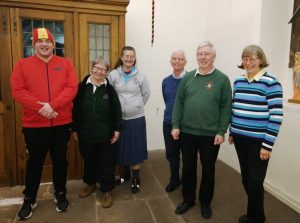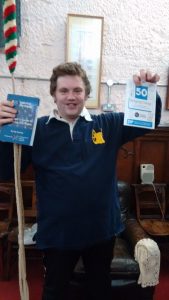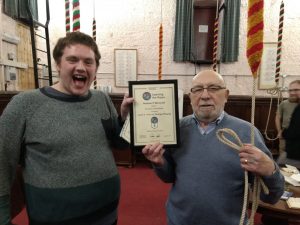
Andrew with his quarter peal band
Following my post on Facebook in mid-November, about a young man who was ringing the treble independently to touches of Plain Bob, Grandsire and St Simon’s Doubles less than three weeks after his first blows in plain hunt on 5 bells, I agreed to share the learning programme we had devised for him.
I was Tower Captain at Cleator Moor at the time and received a phone call: “My son is really interested in bells and wants to ring them but he has autistm. He was refused at [another nearby tower] because they said they are not allowed to teach him.”
Not expecting much, after asking his age (19), I said “Bring him along and we’ll let him have a go, and see what happens”.
When he turned up at Cleator Moor practice, he impressed me with his huge fount of knowledge of names and weights of various large bells around the world, and how many bells in various cathedrals and plenty more. He already knew, through looking at Youtube videos, how the bell is rung, what the stay is for etc. I let him chime a bell then ring it part way up and he had a great feel for it, so I said he could come again for another go, not really expecting much. He strode around looking at everything, asking questions, telling us what he had learned, clearly showing a lot of interest.
Learning to ring the bell
Over the next few weeks, after realising he was going to keep coming anyway, I started to teach him to handle the bell properly. He is a giant of a lad and I am only 5’2″ and I prefer to assist with my hand below the learner’s , rather than on top, which worked pretty well. And he quickly rang both strokes beautifully, gently setting it or balancing, and at this point, the strength of his pull was tempered by my doing one of the strokes so it was always right for him on the other, having constant feedback from me. I worried about when he would do both …
He rang bells up and down, with me managing the coils for him, and surprised me by explaining to his dad how pairs of bells crossed over for call changes, and talking through getting them to Queens (he had never rung even in rounds at this stage and I had explained nothing). Later, he calculated in a flash, how many times the hour bell would ring in a year (I didn’t check but listened to his working out and whether right or wrong, his thinking was fine). At this point I began to realise he had quite some intellect. I asked his dad if he was OK with reading, for getting him a book, and next week he wrote a verse of some flowery poetry about chimes, that he had learned on the whiteboard, with perfect spelling and punctuation.
I thought … maybe … just perhaps … he could end up being the conductor we are lacking in this area? (We have a few bob ‘callers’ who can sometimes do a bit of putting right, but no brilliant conductors)
Then we had a problem….
Putting both strokes together was too much for him. He panicked and after several goes, with masses of wild over-pulling, getting the bell completely out of control, he decided he had bitten off more than he could chew. He could not get his head round all the things he had to do at once and I was rather scared of his strength and my fingers not having a good grip because of arthritis. We went back to single strokes to calm him down, then next week tried again. But he still panicked, striding around saying he would never be able to do it. And he was still scaring me … I am not that strong to stop him breaking a stay if he gave it a full power whack! As we already had a date for the church closing and the bells being taken out, we called it a day.
Fast forward a couple of months and I had done a lot of thinking and regretting letting him go. I talked about it with Richard Last, the Tower Captain at the other church I ring at, Whitehaven. I had been his ART mentor; he was now an accredited teacher and we work well together. His sons are both on the spectrum and although very bright, both had learning difficulties so he had experience that I had not. He had taught them to ring but now wished he had done ART before starting.
I, however was a good Primary school teacher (with plenty of outstanding lesson assessments, specialising in small steps learning, and a support teacher for other teachers. My great interest was in the actual teaching for individual learning, particularly in feedback, with an MA. We decided we could find more ways to introduce new elements in much smaller bites and agreed we should give him another go, with him doing the handling and my suggesting next moves.
But by then I had lost his contact numbers.
It wasn’t till I saw him and his dad on a bus one day, that I was able to offer him another chance. He jumped at it and came along, with great excitement, to his first practice in his new tower. We also agreed that he should change to ringing left-handed. (At Cleator Moor I had accepted other people’s view that he should be taught right-handed.)
His feel for the bell was still good, even though it was in a different tower, and he rang the two strokes separately well, and was able to bring the bell up and down as before. This time, instead of putting the two strokes together as the next move, we got him going through more stages, each done as movements on a bell that was down, before a bell that was up.
- Ringing the bell below the balance, all backstrokes and then first touching, then gently circling, then fully holding and gently pulling the sally, all with just one hand on it, getting his main hand transfers to the tail end sorted and building the feel of the rhythm of both strokes. The bell remained below the balance throughout.
- Catching and pulling the sally with a dummy tail and the bell fully up
- Pulling off at handstroke holding the tail end correctly, transferring the leading hand to the tail when hands low, then ringing the backstroke. I caught the sally and stood it, ready for a repeat.
- Back to ringing the bell below the balance and one hand on the sally as well as doing the tail end to remind him of the rhythm of the whole bell movement.
- Then back to bell fully up, him pulling the first handstroke and doing all the backstrokes and catching the sally with two hands every now and again, increasing this to alternate, until he was able to do them all.
Of course, with all the stages,there was lots of practising the movements on a ‘down’ bell, copying the movements of one of us ringing on a bell that was up and lots of repetition of earlier steps.
Throughout, with so many small steps, there was plenty of opportunity to praise and for him to feel he was progressing, and the were many smiles of pure joy! This was all followed by setting it “I can’t believe I set the bell!!” and “I can’t believe I set the bell at back stroke!!” and “I’ll never set it ten times”, until, “I can’t believe I set the bell ten times!!” He had passed level 1. One night he rang every bell in the tower up (12) and another time he set them all at backstroke.
Time to start ringing with others
Again – small steps. Following me, and I simply made sure I rang before him. Then following me keeping in place, then following me going slower or faster, then dodging with me – both up at hand and up at back. Next, following two bells, watching both to try and match the gap ….

Andrew wearing his 21st birthday present and holding his two new books!
… and before we knew it, he had passed level 2 as well. And got the badges and a t-shirt! Ringing rounds on 6 came easily now he could confidently manage the bell and from the outset he was listening and striking well. All those small achievements brought many smiles of pure joy!
Then …
Call changes were a problem: he panicked at having too many new things to think about – what bell he was on, who he was following, seeing who they were following, working out what to do if he was involved in a change …
I was actually glad about this because I had long wanted to abandon call changes in the learning path, and go straight for developing ropesight and being able to ring in any given place. Richard allowed me to direct his learning in this direction and when it had to be call changes, he rang the tenor at the back and looked at all the ropes to make sure he was last. He was soon able to tell me who he was following by seeing them. When it didn’t create any problem to him, I would ask him who was ringing first, who was ringing second, what order they were ringing in, etc. He started to watch all ringing intently, trying to pick out these. His ropesight was on its way!
Covering to Doubles
First he covered to us ringing Plain Hunt on 3 bells. Then covering to Minimus. To continue the tiny steps approach, in covering to doubles, rather than give him five bells to watch, we chose Cloister. My reasoning was that he would only have three bells to look at to see who was last.
I explained how two bells would alternate, (dodge) for six pulls then one would go and another bell come to work with the one that stayed. There were only three that would come to the back at all. I stood with him, only saying which bell would go and he had to watch for the next one. After a while I stopped telling him as he started telling me. This quickly led to him covering to Stedman, which gave him no problem – he could see the two bells and at a six change pick out which came to the back. He said he could hear the music tell him when it was time to look for another bell.
Next, ringing six bells, we had three bells hunting in 3rds, 4ths and 5ths places, whilst he covered those by looking for the last. We varied which bells hunted so that he had no chance to learn numbers.
Next increased that to covering to Minimus (still on six bells, with treble leading)
Finally covering to Doubles. This probably took about 6 weeks, and all the time I had him watching the ringing and telling me who I was following, who was leading, who was in 5ths place etc.
He was ringing with a good sense of rhythm and striking well, adjusting correctly as needed. Now it was time to try hunting.
Ringing changes
First we put him on the treble to six bells and sorted his leading out. He has a good ear and sense of rhythm so this was not too hard. We started in a small way, again. I rang 2 and told him at the next handstroke to let me ring first and that he should ring second.
We had 1 and 2 cross over every few rows, as call changes. and my instruction to him was “Ring, First” ….. “ring second”…. etc
Then we did the same thing but we alternated leading and making seconds in whole pulls. This is the action for trebling to Bistow so we did that next. If speed was right he could see this and do it well and it also gave the other four ringers something more interesting to do!.
Hunting on three started as call changes, with instructions like “Ring second”, “Ring 3rd”, “Stay ringing third but look for another bell.” “Speed up a little for one pull and ring second again.” Now ring first.” All interspersed with questions about who is leading, who is last etc.
Then we rang this as a proper plain hunt with me giving these instructions every pull, till he started saying them to himself.
He had no problem with any of this, so we rang Cloister with him on the treble, using both Plain Bob and Grandsire starts to stop him picking up numbers, and putting singles in to change the orders.
I was a bit more worried that it wouldn’t work for hunting on four bells so we did ringing just four bells, not six, and the instruction to ring in 4ths place was: “Ring last”, which he could do. Straight away he trebled to Plain Bob Minimus, Double Bob and Grandsire Minimus – anything to stop him learning number sequences. All was going well here – he could see one rope and ring second, see two ropes and ring in 3rd place after them, and see them all go so that he rang last. Then we added two covers in to get the 6 bell rhythm and keep more people involved in ringing.
Crunch time!!
How would hunting the treble to fifths place go?
Week 1 – with me standing with him. I used the same method talking him through place to ring in, how many bells should see ringing before him and telling him the speed he needed blow by blow; he did a couple of plain hunts easily. This young man had either been learning coursing order or had ropesight! So we changed the order. Still no problem.
Without standing, we followed this immediately by a course of plain bob, just wondering…. again, he rang in each place with no problems other than when one of the inside ringers went wrong. Followed immediately with plain course of Grandsire. The only thing I had to do to help was remind him of place and speed when needed, and point out out the first bell (hunt bell) after we changed to Grandsire.
Week 2 – he rang the treble to touches of Plain Bob Doubles – we didn’t want him learning the order for plain courses. The only help given was place and speed, and an occasional point.
Later that week I took him to ring on our monthly Codgers day, and he rang the treble to bob doubles; I had asked for a strong band so that he could see his place easily, but someone on an inside bell kept going wrong, so I later asked if he could treble to a 120 of St Simon’s, ( hopefully guaranteeing a better band!) He managed this very little help and absolutely glowed when he got a lot of praise from the other ringers.
Then the next day, just two weeks to the day after his first ever go at plain hunt on five, he rang the treble to 120 Plain Bob Doubles with no one standing behind.
Since then, in the last eight weeks or so he has rung 5 – 6 to plain hunt on handbells (but doesn’t like it), rung the 2nd to Grandsire, trebled to Little Bob Minor, Plain Bob Minor and is now ringing Cloister on a working bell, with either Grandsire or Plain Bob start. We have agreed that he will learn Stedman front work as a kaleidoscope exercise and then show how it extends Cloister, so that he is ringing Stedman.
When the time comes, we will move him to the 5th and use exercises like Slapton Slow courses and Bayles to learn the work of Plain Bob Doubles inside, in individual steps, rather than trying the whole plain course from the outset, as is more usual. The reason for this is to take out the added difficulty of ropesight when ringing the more usual No 2 bell and the long gaps between each piece of lead end work.
If you have read this far, you will probably realise that what we have done throughout is to break each progression up into as many steps as possible, responding to what we have found successful with him and building on it,

Andrew with Jack McTear receiving his Level 3 Certificate
Meanwhile, Andrew has now gained his Learning the Ropes Level 3 by ringing the treble to a quarter of St Simon’s m/v, a very good even piece of ringing with only one tiny trip – when we forgot to warn him that a Reverse Canterbury Bob would not affect him and all he had to do was lead as normal. When the bob changed to some other kind I heard him say “Just lead hand and back as normal”!!
And this week, I suggested he stand behind someone having her first go at trebling to Plain Bob Minor and was delighted to see him pointing out who to follow a couple of times when she had missed it. He got his own first go at plain hunt on 6 just after and did it beautifully, even with numbers swapped round. The next day we put him on the treble for a touch of Plain Bob Minor and the only help he needed was reminding not to hold his backstrokes up when approach the lead.
I am delighted at his progress and often tell him proud I am of him, and was really pleased when that the Tower Captain said he now sees that letting people ring by learning bell orders is counter-productive if you want a change ringer and this is how we will be working in future, in fact we have already started some number dependent ringers on their new path!!
Andrew loves visiting new towers and never has any problem with any bells, large or small. He likes to test each bell to see if it is up or down, loves interacting with other ringers, who are, without exception, very encouraging! He likes being introduced and doesn’t forget names; he loves doing various jobs in the tower and is a really useful member of our band. His love of ringing shines out like a beacon, giving pleasure to all who ring with him and great joy to those who teach him!
Chris de Cordova


What a good read! Very encouraging . It’s great that people care , and will go the extra mile to help others
Well Done
i cant believe that i am on level 5
Hiya ..Cant believe ive been bell ringing now 8 months and im still going stromg…and progressing……Assesment 1 is the goal for this year…. As for ringing the changes…..?….Well maybe next year ..Its good fun and keeps your figure in trim .. So heres to 2018….
That’s great to read. We ‘inherited’ an autistic ringer in my previous tower – and I confess that I didn’t do all that I might have done for him. He has followed me (on practice night) to my new tower, where he is delighted to be one of the helpers with our new band. It is wonderful to see how he has matured.
(I’m just – as always – jealous at your opportunity to choose all those diffferent methods! One day, we’ll have a competent band that can offer such a rich learning experience to our learners!)